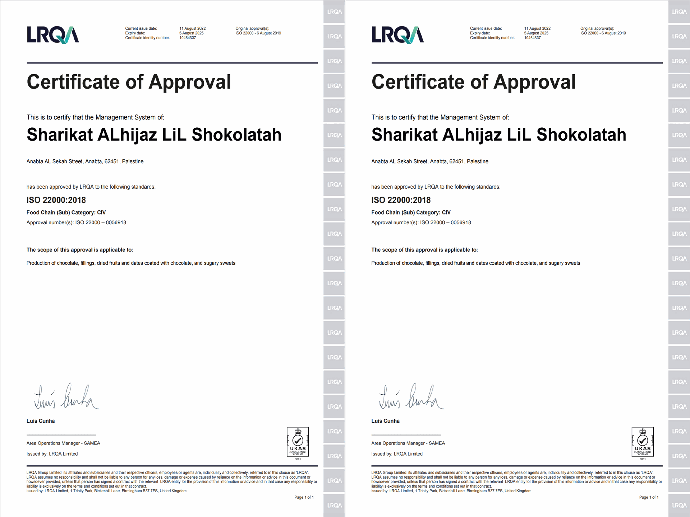ISO 22000 FSSC
ISO 22000 Standard: Issued by International Organization for Standardization (ISO), it establishes a monitoring system that includes the development of preventive or corrective procedures to prevent food contamination hazards, ensuring all chocolate varieties are safe for consumption from the moment of production until they reach the consumer. It enhances consumer confidence in the quality of our products.
The standard includes identifyning, evaluating, and preventing potential hazards that may effect food safety :
1.Biological Hazards: Include bacteria, viruses, parasites, and fungi.
2.Chemical Hazards: Include contaminants such as natural toxins like aflatoxin, and unauthorized additives.
3.Physical Hazards: Include any unintended substance in food that causes harm, like plastic, stones, and metals.
The ISO 22000 Standard Includes Several Elements:
1.Food Safety Management System (FSMS): Establishing quality and food safety policies and objectives, and determining how to achieve them to assess the organization's compliance.
2.Hazard Analysis and Critical Control Points (HACCP): as a methodology for identifying and controlling or eliminating hazards. For example, hazard identification: product contamination due to workers, Critical Control Point (CCP): through food safety instructions and providing training for workers on personal hygiene during work. Control measures: daily compliance monitoring by the quality and food safety controller. Periodic control through laboratory swabs to ensure that the work environment and surfaces are free of contaminants. Corrective actions: in case of early detection of contamination, steps should be taken to remove the source and enhance training and supervision. Documentation and recording: record all actions and results related to workers' training, daily monitoring, and laboratory tests. Verification and review: periodic review of the effectiveness of the measures taken and updating them as necessary. This approach helps to ensure the identification, reduction and prevention of contamination risks in the food production environment, there by enhancing the safety of the final product.
3.Pre-Request Programs (PPRs) - Supportive programs for a safe work environment, related to hygiene, training employees, maintenance of facilities and equipment, supplier management, pest control, waste management, emergency preparedness, traceability system, and control of temperature and humidity.
4.Verification of System Effectiveness and Continuous Improvement: Through the collection, organization, and analysis of verification data, records of non-conformities in ''Good Manufacturing Practices'' (GMP) tours, internal and external audits; documentation and recording of procedures and policies, and maintaining records that prove system effectiveness.

FSSC 22000: While ISO 22000 provides a comprehensive framework for food safety management, FSSC 22000 adds specific additional requirements and more detailed prerequisite programs (PRPs), as well as international recognition by the Global Food Safety Initiative (GFSI). These additions enhance the reliability of the food safety management system and help companies achieve broader acceptance in international markets.
1.Specific Additional Requirements: The specific additional requirements of FSSC 22000 include elements such as food defense control, allergen management, incident management and product withdrawal, and human resources management.
2.Enhanced Prerequisite Programs: While ISO 22000 requires prerequisite programs (PRPs), FSSC 22000 specifies additional or more detailed requirements related to aspects such as hygiene, pest control, equipment maintenance, and waste management.
The FSSC 22000 standard aligns with other management standards such as ISO 9001 (quality management) and ISO 14001 (environmental management), facilitating the implementation of other management systems within our company.